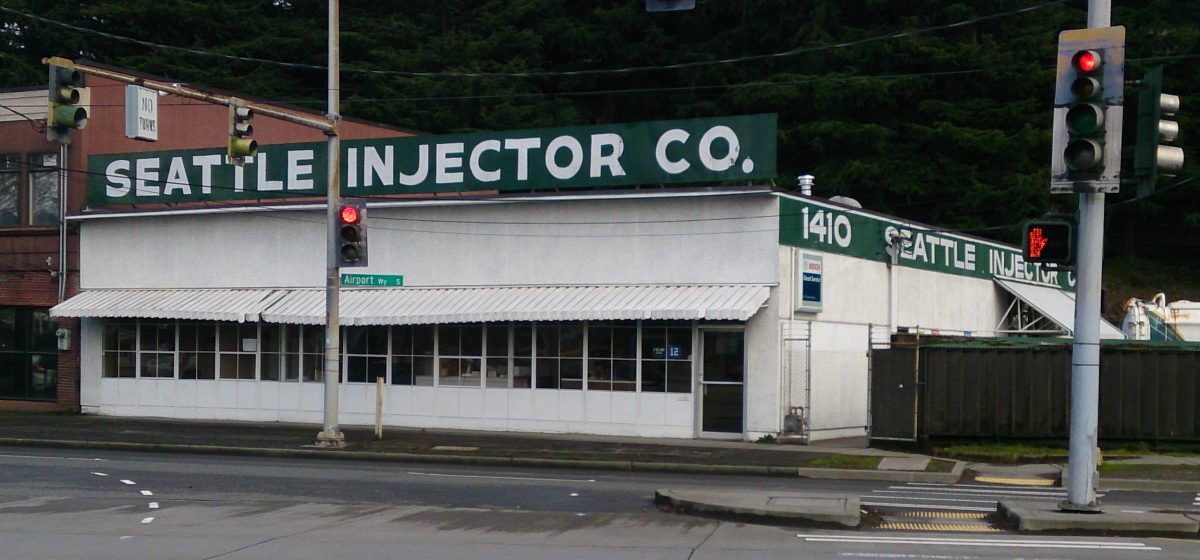When we returned from our trip last fall, the engine had low power after we arrived at Port Ludlow, before we crossed Puget Sound through the canals and home.
I figured and, after speaking with our marina mate, Nate, decided that we had injector problem.
In late February of this year, I spoke with Rick at Seattle Injectors, the company that Nate suggested. They would have time to do our injectors the day after I dropped them off.

One of the reasons I decided that Maxi was the boat for us was because the engine is in the middle of the cabin and is completely accessible, 360°. Removing all three injectors was less than a 20 minute operation: crack open the table, detach each injector line from the injector, loosen the two bolts holding each injector in place, then merely lift out the injector.
Rick was quite surprised to see me so soon, was very pleasant, and treated me as an equal. Dealing with commercial vendors, or perhaps just Seattle, is very nice. Sometimes in retail settings people on the other side of the counter can be condescending.
Rick answered my questions, and pulled out parts of another injector to illustrate his points.
He gave me a quote and then suggested I talk with MER about what new injectors would cost. Very nice. (Because I don’t have an account with them, I was quoted retail.)
When I went to pick up the injectors, Toby, the tech, spoke to me about water in the fuel as the cause of the problems.
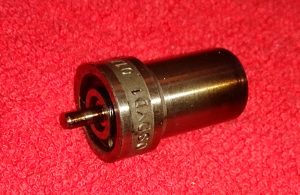
After disassembly, the rods inside the injector should fall out of their housing. Two of the three couldn’t be removed, period. Toby suggest the additive they recommend. When we had a clogged filter we found it was because of an emulsion of fuel and water. Perhaps I hadn’t been conscientious about adding additive. I also seem to remember the additive saying it kept water in suspension.
The new additive’s label went to lengths to explain that water in the fuel would not stay in suspension, but fall out of the fuel and be handled by the water separator. I told Rick I would take some.
The bank, however, would not accept the purchase because two transactions, one behind the other, at the same vendor is flagged as a potential fraud.
I told Rick not to worry about it, and I’d buy it another time. Instead, he asked me how much I paid to have the three injectors rebuilt. I told him $379. He paused for a second, thought this through, and then said, “Take it for free.” This gave me an idea about the difference between the retail price and the commercial price.
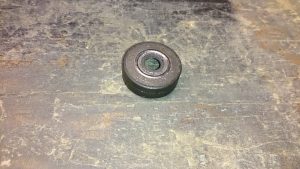
While the injectors were being rebuilt, I removed the three spacers from the injector bores in the engine. The spacers either form the top of the injector chamber, or merely sit on top of it. Beneath the spacer is a metal washer (probably steel), above the spacer is a fibrous washer, and about the fibrous washer is the very thin copper washer. The injector compresses all three together when it is inserted into the bore.
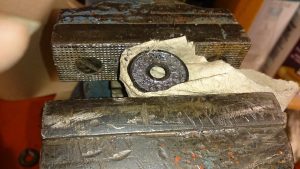
To remove the fibrous washer from the spacer I held the space in a vise in the workshop, with a paper towel for padding and scraped off the fibrous washer using a wood chisel.
When installing the last, and most forward injector, I had trouble pushing the spacer into the bore. By looking straight down the bore, the headlamp I was wearing to do the assembly showed the metal washer had lifted off the top of the injection chamber and was cocked.
It was nothing to put it back in position, but in the confusion I left out the thin copper washer.
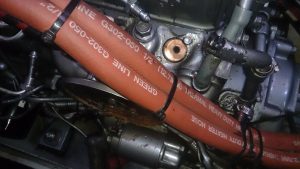
It was only when I was cleaning up, that I noticed a thin copper washer under the packaging from the replacement parts.
When I pulled out the injector, the fibrous washer partially adhered to the injector and needed to be replaced. It almost goes without saying (but I will) that MER did not have one more fibrous washer in stock. It would be there the next morning on the truck.
This was my third visit with MER in one week. By now Norm and I were old friends. The phones and the counter were quiet, so we spent some time discussing exhaust technology, and a four-year jaunt he had taken into small business ownership restoring vintage Ford Mustangs. He said it was among the best times of his life, but it didn’t make any money.
The nice lady from the front office came back to wrestle with my refund, but was unsuccessful.
When I went to pay for the washer, Norm told me it was on the house. I told him I wouldn’t argue with that, and he replied, “Few people ever do.”
I assembled everything, bled the fuel lines, and started the engine. But didn’t get much power.
It was still early enough in the day that I could grab a 3:45 ferry to Bainbridge Island and get home by 6 PM, which I did.
I intended to order a new Racor filter, to replace the very difficult filter that’s installed there now, and as part of it I will redo all the connections coming from the tank to filter. [17-March – The filter has arrived here in Port Townsend. I’ll install this week, but may not plumb it in, until we are in the water where I can easily restart the engine and let it run.]
The next week, Jennifer Hilary and I traveled by mass transit from Port Townsend to Lee’s Landing.
While Jennifer and Hilary ran some errands, Nate came by, walked me through bleeding the injector lines from the injection pump, and explaining any air in those injector lines compresses interfering with the operation of the injectors. It is the pressure pulse from the injector pump in the injector lines that opens the injectors. The compressed air softens the pressure pulse, so the injector may not open properly, if at all. With the engine running at 1200 RPM, Nate systematically opened each injector line, catching any diesel fuel with an absorbent pad, hopefully bleeding air.
Among the many things we did was to disconnect the flexible fuel line from the fuel filter, and insert it directly into a portable diesel fuel tank, to see if there was any difference in the behavior of the engine. There was not.
A number of people have suggested, including Rick at Seattle injectors, that the air was getting in close to the fuel tank, at either the fuel tank connection or at the filter. I’ve begun to give this theory more credence. One scenario is that there is being sucked in the entire time the engine is running, and gatherers when the engine is off. The rest of the time it is being pushed through the injectors.
Jennifer, Hilary, Nate and I took CaroBabbo for a test drive around Lake Union. We towed Nate’s dinghy with our outboard, in case we had engine problems.
The engine ran well, but would stall whenever Jennifer took the engine out of reverse, but not when she took it out forward. The engine would easily start each time, and Jennifer now has enough experience that she feels no panic when it does.
The day after that, Thursday, March 2nd, Jennifer Hilary and I sailed to Port Townsend, towing our dinghy. We took the dinghy in case we had engine problems, so we could use it ‘‘on the hip’’ and get us wherever we needed to go.
The engine ran well, but did continue stalling whenever it was taken from reverse to neutral, but started quickly and easily each time.

On Friday, March 3, Jennifer drove the boat from the slip we rented over to the 75-ton lift, and this time the engine did not stall when coming out of reverse.
[Caro Babbo is currently on the hard. The mast is down, the ‘‘bottom has been ground off,’’ meaning all the many layers of bottom paint have been sanded off, and new barrier paint and ‘‘coppercoat’’ will be applied in sunny weather starting tomorrow. The next post will talk about being on the hard.]

